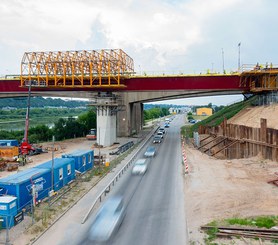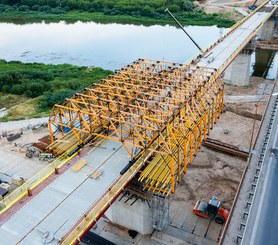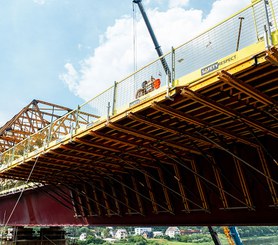Description
Iceland street in Kaunas is the most intensive communication artery in Lithuania. Every day more than 78,000 cars pass through the road, so traffic is very heavy. A new traffic lane was opened on the new bridge over the Neris, in the section of the Vilnius-Kaunas-Klaipeda highway from km 99.29 to 100.47. The new connection has significantly improved the communication conditions for the people of Kaunas, as four traffic lanes are exclusively for local traffic.
UAB ULMA CONSTRUCCION BALTIC, in cooperation with the general contractor AB Kauno tiltai, joined the implementation of this important project. The bridge is located in the "Natura 2000" protected area, so some particular works could only be carried out at a certain time of the year.
The impressive length of the structure, reaching as much as 352 meters, and the fast pace of work required an innovative and bold approach.
ULMA Solution
ULMA CONSTRUCCION BALTIC designed and applied unique formwork solutions, using the universal MK formwork system for the construction of the bridge slab. The equipment supplied was used for the construction of the steel deck, abutments, viaducts, and retaining walls of the composite concrete bridge. To build the wings of the bridge deck, formwork brackets made of standard MK system components were used. This structure, divided into 3 modules, thus facilitating its assembly, provided the necessary rigidity, but at the same time did not make the structure too heavy. The standard solution adjusted according to the customer's order ensured maximum cost-effectiveness. To increase the pace of work, 12 formwork brackets were used, making up a 25-meter section. The concrete casting was carried out starting at the center of the span, with the two form holders moving in opposite directions towards the respective supports. Thus, at each stage, sections of 25 m in length are poured into the sections specified by the designer. The mold holder is moved by a simple wheel system to the next segment of the bridge. The light weight of the MK system components made it easier to assemble large structures by hand. In this way, the crane could only be used for lifting construction modules already assembled on the ground. This was a key factor in reducing project costs.
To speed up the work, two 24.0 m carriages were used, which are moved every 7-10 days with the help of a hydraulic system. The trusses of the MK system were placed in such a way that it allowed concreting sections from 19.8 m to 22.0 m.











